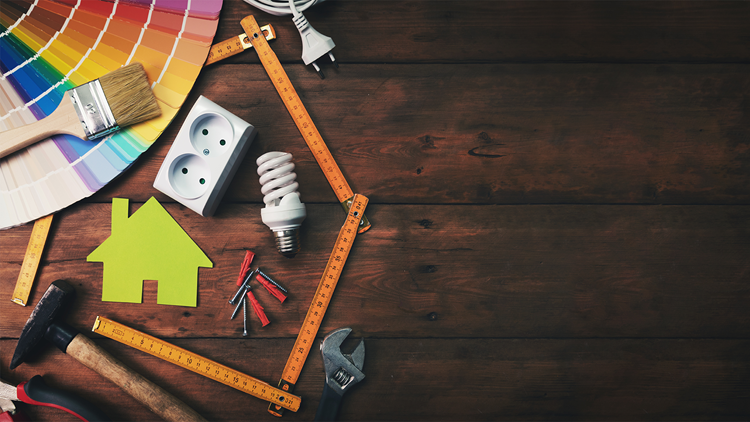Sponsored story by: KEMBA Financial Credit Union
Your home is one of the biggest investments you’ll make in your lifetime. Unlike other high-ticket items you may purchase, like vehicles or electronics, your home appreciates, or gains value, over time.
As you pay your mortgage, you build equity. Timely and consistent payments can increase your equity, but the right home improvement project could help accelerate the value of your home.
How can you make improvements that add equity without burning through your liquid savings? A HELOC might be a solution for you.
Home Equity Line-of-Credit (HELOC)
HELOC stands for Home Equity Line-of-Credit. As the name states, this is a line-of-credit product that allows you to borrow money against the equity of your home. A HELOC provides the cash you need for large purchases like a kitchen remodel, replacing your old deck, converting an outdated bath, and more. These high-ticket items can be difficult to save for, but using your existing home equity is an easy option to fund these types of improvements while keeping your liquid savings.
A HELOC is different than a Home Equity Loan, which also borrows from your home’s equity, but is disbursed in one lump sum. A Home Equity Loan is set up as an installment loan that begins when you receive funds, which means you will start making payments shortly after your closing.
A HELOC is not a loan, but a line-of-credit, which means you can draw on funds as you need them for up to 10 years, making a HELOC a source of funding for years to come. You can request checks or a debit card to make purchases against this line-of-credit, and unlike a home equity loan, the monthly payments do not start until you draw funds. The monthly payments are divided between interest to your lender and repayment of the HELOC principal, so making your payments rebuilds the equity that you borrowed against. Typically, most lenders have a 20-year repayment period after a 10-year draw period.
How a HELOC Works
The first step to exploring a HELOC is to plan how you want to use the funds to add value to your home. Identify the projects you want to work on most prior to applying so you can prioritize and plan better. The next step is to determine how much equity you have in your home. With housing prices at all-time highs and real estate listings spending an average of just six days on the market, your lender may require an appraisal to determine the value of your home. Your home might be worth more in a seller’s market than it was when you bought it, even if that was just a few years ago. Once the appraisal is complete, you can determine how much equity you have, and how much you could borrow.
To calculate your equity, take the appraised value of your home and subtract the amount that you currently owe on your mortgage. For example, if your home appraises for $100,000 and your mortgage balance is $50,000, your home equity is 50%. Most lenders have a maximum amount they will extend in HELOC funds, which means the Loan-to-Value (mortgage balance divided by appraised amount) ratio can’t exceed 90%.
Since a HELOC is a mortgage product, when you are approved, your lender will place a second mortgage lien on your house, ensuring that the bank will be repaid for the balance due if the home is sold before the HELOC balance is paid. This means you are essentially using your home as collateral, so using your HELOC wisely is important.
Common Mistakes With HELOCS
Since a HELOC ‘cashes out’ home equity, you want to be smart with your HELOC and spend the money on improvements that will increase your home’s value.
Here are a few common mistakes that consumers make when using a HELOC:
- Using the funds to buy depreciable assets is a common mistake. Cars, boats, or vacations are purchases that decrease your equity and overall net worth. In the moment, these purchases may seem like a good idea, but are the types of expenses that should be saved up for rather than using home equity to fund. While a HELOC can be used towards appreciating financial goals such as helping to consolidate bills, paying for college, or establishing an emergency savings, aim to use the HELOC for home improvements that will add value to the home itself.
- Borrowing too much can also create problems for your monthly mortgage payment. Since most lenders require 20% equity to avoid Private Mortgage Insurance (PMI), borrowing too much against your equity may trigger an additional PMI payment each month. In addition to a new HELOC payment, your mortgage payment may increase, which may strain your monthly budget.
- Overpaying for home improvements or upgrading areas of your home that don’t add value is also discouraged. Installing a new pool may be a valuable upgrade to you, but a future potential buyer may see it as a liability, which can decrease the value of your home. Stick to areas of your home that increase in value as you remodel, such as kitchens, bathrooms or additional square footage.
- Paying high interest rates on a HELOC increases your monthly payment and will take longer to pay off. Choose a lender that has low home equity line-of-credit rates to keep your monthly payments low.
Open a HELOC with KEMBA
If you are looking for more information about a home equity line-of-credit, KEMBA is a great place to start. KEMBA has a current special where you’ll pay 1.99% for the first 90 days, and a low rate after the initial introductory period. To get started on the process of exploring and applying for a HELOC, call our member service team at 614.235.2395, option 4, or visit one of our local branches.



